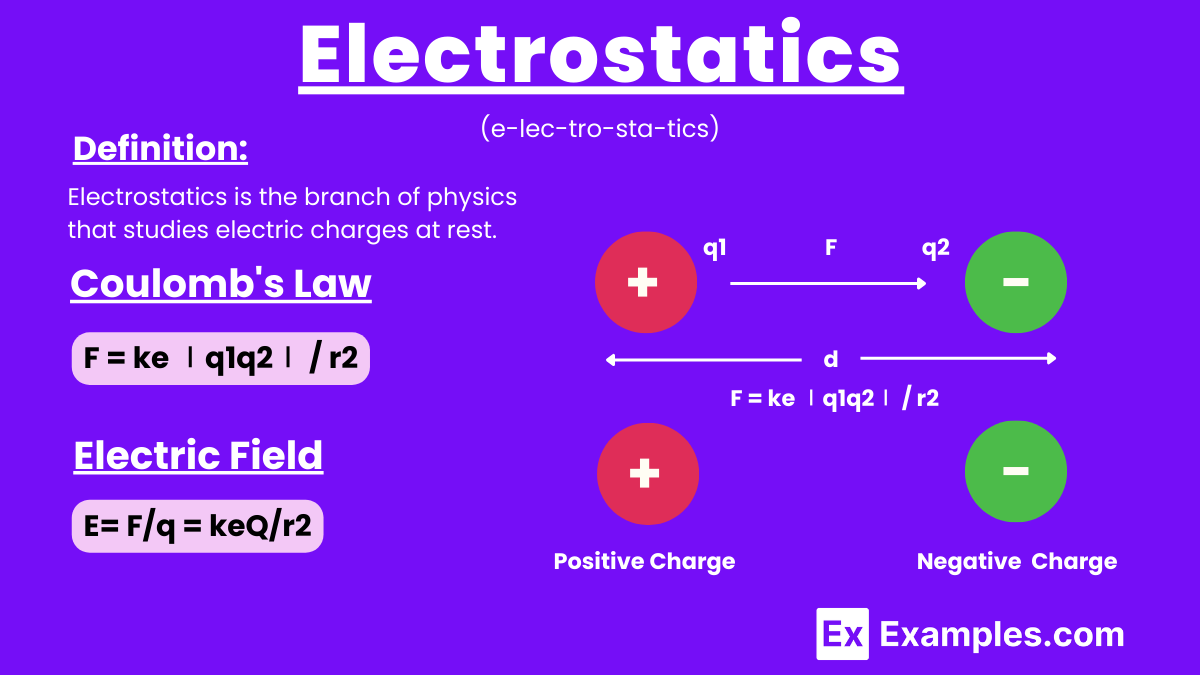What is the unit of electric charge?
Ampere
Volt
Coulomb
Ohm


Electrostatics is the branch of physics that studies electric charges at rest, focusing on the forces, fields, and potentials arising from stationary charges. Key concepts include Coulomb’s Law, which quantifies the force between two point charges, and Electric Potential, representing the potential energy per unit charge. The Superposition Principle allows the calculation of the net electric field by summing the fields from individual charges. Static Electricity Formula involves the accumulation of electric charge on an object’s surface, described by formulas such as Coulomb’s Law. Electrostatics is crucial for understanding phenomena from lightning to capacitors in electronic circuits.
Electrostatics is the branch of physics that studies electric charges at rest, focusing on the forces, fields, and potentials they create. It includes phenomena such as attraction and repulsion of charges, behavior of conductors and insulators, and charge distribution. Electrostatics has applications in technologies like capacitors and photocopiers.
Where:
Where:
Where:
Where:
Where:

Coulomb’s Law describes the force between two charged objects. It states that the electric force between two point charges is directly proportional to the product of the magnitudes of the charges and inversely proportional to the square of the distance between them. The force acts along the line joining the charges.
Mathematically, Coulomb’s Law is expressed as:
Coulomb’s Law is fundamental in explaining various electrostatic phenomena, including the behavior of electric fields, the operation of capacitors, and the principles of electrostatic potential energy. Some practical applications include:
Electric potential is the work done to move a unit positive charge from infinity to a point in an electric field.
A conductor is a material that allows the free movement of electric charges, facilitating the flow of electric current.
An insulator is a material that does not allow free movement of electric charges, thereby inhibiting the flow of electric current.
Charge quantization means electric charge exists in discrete amounts, and the smallest possible charge is the charge of an electron or proton.
The principle of superposition states that the total electric force on a charge is the vector sum of individual forces exerted by other charges.
A dipole moment is a measure of the separation of positive and negative charges in a system, represented as the product of charge and distance between charges.
Electric fields are represented by field lines that start from positive charges and end on negative charges, showing the direction and relative strength of the field.
Electrostatic induction is the process of redistributing electric charge in an object due to the influence of nearby charges without direct contact.
The electric field is the negative gradient of the electric potential, meaning the field points in the direction of the greatest rate of decrease of potential.
A capacitor is a device that stores electrical energy in an electric field, created between two conductive plates separated by an insulator.
Text prompt
Add Tone
10 Examples of Public speaking
20 Examples of Gas lighting
What is the unit of electric charge?
Ampere
Volt
Coulomb
Ohm
Which law describes the force between two point charges?
Newton's Law of Gravitation
Coulomb's Law
Ohm's Law
Faraday's Law
What is the value of the Coulomb constant \( k \) in a vacuum?
8.99 x 10^9 N·m²/C²
1.60 x 10^-19 N·m²/C²
9.81 m/s²
6.63 x 10^-34 J·s
What happens to the electric force between two charges if the distance between them is doubled?
It becomes twice as strong
It becomes half as strong
It becomes one-fourth as strong
It becomes four times as strong
If the charge on an object is doubled, what happens to the electric force between that object and another object with the same charge?
It is doubled
It is quadrupled
It is halved
It remains the same
What is the electric field due to a point charge \( Q \) at a distance \( r \) from the charge?
\( \frac{Q}{4 \pi \epsilon_0 r^2} \)
\( \frac{Q r^2}{4 \pi \epsilon_0}\)
\( \frac{Q r}{4 \pi \epsilon_0}\)
\( \frac{4 \pi \epsilon_0 Q}{r^2} \)
What does Gauss's Law relate to in electrostatics?
Magnetic fields
Electric field and charge distribution
Gravitational force
Electrical resistance
What is the principle of superposition in electrostatics?
Total electric field is the sum of fields due to individual charges
Total electric charge is conserved
Electric potential is the sum of potentials due to individual charges
Charge distribution remains unchanged
How is electric potential difference related to electric field?
\( V = \frac{E}{d} \)
\( V = E \times \frac{d}{2} \)
( V = \frac{d}{E} \)
\( V = E \times d \)
What is the relationship between capacitance, charge, and voltage?
\( C = Q \times V \)
\( C = Q + V \)
\( C = \frac{Q}{V} \)
\( C = \frac{V}{Q} \)
Before you leave, take our quick quiz to enhance your learning!

